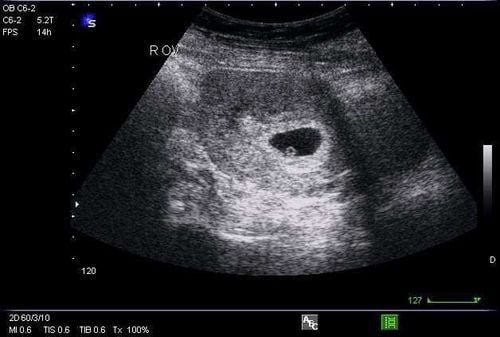A prenatal ultrasound finding a pericardial effusion less than 2mm thick is normal. However, if the pericardial effusion in the fetus is 2mm or denser, it may be related to structural heart abnormalities or congenital diseases.
1. Introduction to the structure and role of the pericardium
The pericardium is a fibrous sac that surrounds the heart and the roots of the great vessels. The pericardium consists of two layers: the parietal (outer) layer and the visceral (inner) layer.
The role of the pericardium is to prevent sudden expansion of the heart (especially the right heart chamber) and strong displacement of the heart and great vessels. The very thin physiological fluid layer in the pericardial cavity helps to minimize the friction of the heart with surrounding structures during each contraction, and the pericardium also has the task of helping to prevent the spread of infection or cancer cells from the lungs and pleura.
2. What is pericardial effusion in the fetus?
Fetal echocardiography finding a pericardial effusion layer of less than 2 mm is common, occurring in about 40–50% of normal fetuses. This feature is most easily detected when the ultrasound beam is perpendicular to the ventricular wall. This finding has no clinical significance and is not considered a pericardial effusion.
Fetal pericardial effusion is determined by ultrasound examination if the heart is partially or surrounded by fluid that can be seen in all projections, usually around the atrioventricular groove. At the same time, the thickness of the fluid layer must be greater than 2 mm and cross the atrioventricular groove.
If the thickness of the fluid layer is less than 4 mm, it is considered a small pericardial effusion; conversely, if it is greater than 4 mm, it is classified as a large pericardial effusion. The main differential diagnosis of fetal pericardial effusion is pleural effusion. This finding also frequently appears on ultrasound as a layer of fluid surrounding the lungs.

3. Causes of fetal pericardial effusion
Fetal pericardial effusion can be found as a single manifestation or in combination with various abnormalities in the heart as well as in other organs. The incidence is about 0.64–2.00%. Therefore, when fetal echocardiography detects pericardial effusion, the fetus needs to undergo a comprehensive ultrasound to rule out various causes related to this effusion.
In most cases, pericardial effusion occurs as a manifestation of fetal hydrops, due to immune or non-immune mechanisms. However, this finding must exclude the possibility of fetal pericardial effusion secondary to inflammation, infection, malignancy, or autoimmune disease.
Accordingly, common pathologies associated with fetal pericardial effusion are as follows:
- Fetal arrhythmias;
- Congenital heart defects;
- Fetal cardiac tumors, such as fetal pericardial teratoma;
- Increased incidence of chromosomal abnormalities, such as trisomy 21;
- Fetal infections;
- Parvovirus, CMV, and HIV infections

4. How to handle pericardial effusion in the fetus
When pericardial effusion is detected in the fetus, the doctor will need to perform a complete ultrasound assessment of the fetus and maternal blood tests to determine the presence of abnormal antibody groups. This is done non-invasively through maternal venous blood sampling. However, in cases with high suspicion of abnormality, amniocentesis, and umbilical cord blood sampling should be considered. If no cause is found, the pericardial effusion in the fetus is considered to be transient and idiopathic. These cases have a good prognosis and nearly 45% of cases will resolve spontaneously after the baby is born.
For cases of high-output heart failure secondary to fetal anemia, arrhythmia, or congenital heart disease, the mother and fetus should undergo in-depth studies for differential diagnosis. In cases of fetal anemia, pericardial effusion is an early sign of fetal hydrops, which should be treated early to limit the risk of stillbirth.
In cases of cardiac teratoma, pericardial effusion may be due to tumor irritation of the pericardial layers and rupture of cystic areas in the pericardium due to the polycystic nature of the pericardial tumor. In addition, the tumor may cause mechanical obstruction of the venous return and thoracic duct, obstructing lymphatic drainage, and leading to the progression of pericardial, pleural, ascites, and fetal systemic effusion. Esophageal compression may cause polyhydramnios. At this time, pericardial effusion and space-occupying effects are the causes of fetal cardiac tamponade.
However, fetal pericardial effusion is rarely associated with malignant tumors. Several cases of cardiac rhabdomyoma with pericardial effusion have been described in the literature due to rapid muscle growth and the onset of arrhythmias. There are a few cases of fetal pericardial effusion associated with cardiac fibroids and hemangiomas. In a few cases of pericardial effusion associated with cardiac diverticula, the mechanism is thought to be due to friction of the reticulum against the pericardial wall.
In summary, fetal pericardial effusion occurs when there is excessive fluid accumulation in the pericardial cavity of the fetus in the uterine cavity. To be considered abnormal, the thickness of the pericardial fluid must be greater than 2 mm. These cases require further in-depth examination to find the cause and timely treatment, ensuring a safe pregnancy. If no abnormalities are detected, fetal pericardial effusion may fortunately be considered idiopathic and resolve spontaneously until the baby is born.
To arrange an appointment, please call HOTLINE or make your reservation directly HERE. You may also download the MyVinmec app to schedule appointments faster and manage your reservations more conveniently.













